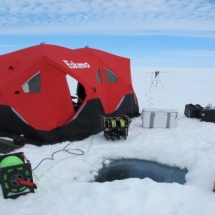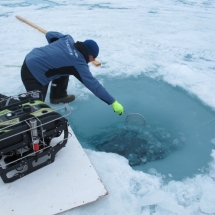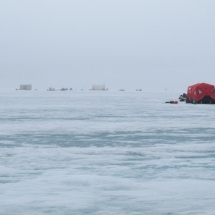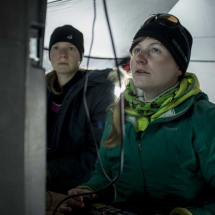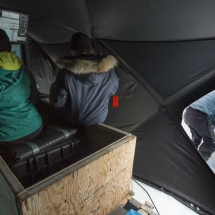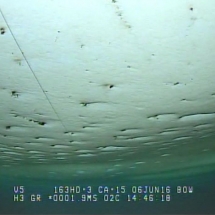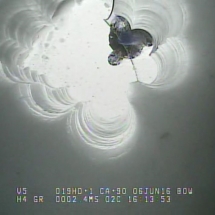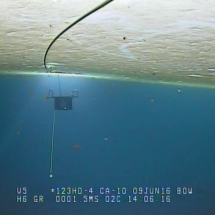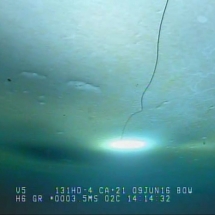Being a pilot in the Arctic - interactive update!
Let’s have a look into the difficulties of operating high-tech equipment in the Arctic environment. But I don’t mean airplanes; I want to talk about flying a remotely operated vehicle, an ROV for short, in the water column beneath 1.5 m thick of landfast ice.
A multi-use device
This 200-lb submersible robot is equipped with 6 thrusters, 2 cameras, a 300 m tether and 3 light sensors. Our goal is to monitor changes in the amount of light penetrating through the snow and ice cover over the melt season. In winter, the thick snow layer reflects most of the solar radiation, so that less than 1 % reaches the ocean underneath. In late spring, the snow starts to melt and forms big areas of surface water, called melt ponds, on top of the ice. These ponds have a much darker surface than the snow and therefore reflect less light. More than 20 % of solar radiation is transmitted through the ice and is available for algal production in the water below.
Handling the ROV
The ROV gives us the possibility to record the light directly under the ice over hundreds of square meters at different depths. But driving against the tidal current and in a specific direction isn’t easy. One person has to pilot the ROV with a little joystick and a live video stream. A second person watches the data coming in: time, depth, distance to the ice bottom, salinity and, of course, underwater light conditions. The tricky part is to get every sensor working. You have to start the ROV and the software in the right order. If you forget only one program before you open the next, you have to reboot the entire system and start from the beginning. This makes for a lot of “fun” particularly on those days, when it is cold and wet outside. If we are lucky and every input is shown on the monitor, we start installing a fishing line along the underside of the ice, which we can follow to measure light transmission over a known distance and position.
The ROV doesn’t have a navigation or location system, which gives the operator the opportunity to be creative in locating the little vehicle under the ice. With a string we can leave the ice surface untouched. However, we have to first find the hole with one end of the string, grab the string with the ROV and pull it back to the big hole at our end. This is quite difficult because the pilot has to use under-ice structures and the commands of a third person who is watching the tether to drive the ROV in the direction of the small hole. Once everything is set up we do horizontal transects and vertical profiles along the string to study the effect of ice surface properties, ice algae and phytoplankton on light penetration. On team member is also interested in the direction of the light (radiance) beneath the ice, which is measured by a fisheye camera on a sledge. At the end of the day, we monitor the surface properties: Light reflection (albedo), snow or melt pond depth and surface coverage with the help of an aerial drone.
An impressive equipment
Handling the ROV is like playing a video game. But it doesn’t mean that we are couch potatoes. Our equipment consists of big, heavy boxes which have to be carried from the Polar Heaven tent to the Qamutik every day. Our fellow camp members joke that every time they find a heavy box they can be sure it belongs to the ROV team. And what can I say? It’s true! But I am proud of my new arm muscles. Furthermore, we work outside all day and the climatic conditions in the icy environment can change quickly. One day, the sun turns the tent into a sauna and the big ROV hole looks like a refreshing pool at a Mexican beach inviting you to jump in. On another day, even your thermal ski underwear is wet and you have to secure your tent with ice screws so it is not blown away by strong winds. But even then, it is an amazing experience to sit in a Qamutik on a piece of ice surrounded by mountains and watch little Arctic cod and zooplankton in front of your ROV camera.
Immersion in cold waters of the Arctic ocean
Now, we want to let you feel like you are the ROV pilot. The ROV was equipped with a special fish-eye lens camera that enables interactive 360-degree videos. An example of such a video can be found here:
With the help of your mouse or the rotate/pan button in the top left, you’ll be able to rotate your view in the upward hemisphere.
You’ll start your journey on the ice surface, dive through the ice hole and follow a string that we had installed. The ROV is flying 50 cm below the sea ice bottom. To give you a little orientation, the ROV dives through the freshwater layer in the hole which makes the video blurry for a short moment. Afterwards, you can see our expedition tent as a big black shadow close to the hole and air bubbles sticking to the ice bottom. Further down the string, many little black spots appear. Those are organic particles which got caught in salt water channel (brine) openings. Enjoy the different ice structures and ice algae formation!

